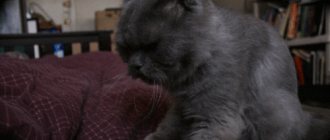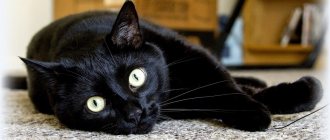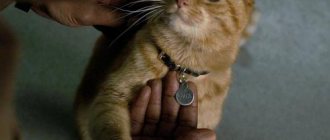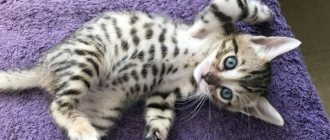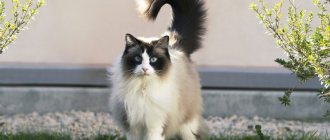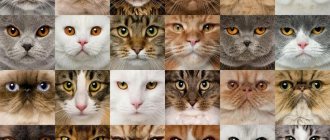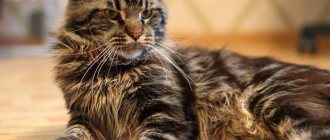Features of the breed and external characteristics
Temminck's cat lives in tropical forests scattered throughout Asia. The breed was first described at the end of the 19th century, but references to this unusual animal can be found much earlier. Currently, the population of golden cats is small and numbers about 10 thousand individuals.
Externally, the golden Asian cat resembles a puma in many ways. It is distinguished from domestic cats by its impressive size and well-developed muscles. The height of adult individuals can reach 100 cm, and the weight category often reaches 16 kg.
The animal has a long tail , small ears with rounded tips, and a small head with a rounded shape. eyes look amazingly attractive , standing out effectively against the background of bright red fur.
Their fur The top is covered with a fatty layer that protects the animal from moisture, cold, and dampness. The color of the Asian golden cat is completely unique - a bright yellow golden hue or a rich dark brown with a reddish tint.
The fur sparkles in the sun, shimmering with all shades of gold, which is why this breed got its original name. Temminck cats of gray or black color are extremely rare. But spotted individuals are widespread among representatives of this breed.
Purchasing a Temminka kitten
This animal is now listed in the first CITES appendix, and smuggling is subject to a large fine and even imprisonment. Even large zoos find it difficult to acquire these rare and unique animals.
Only from single foreign breeders, with a long and persistent search, can you find “legitimate” kittens born from cats who themselves grew up in captivity and have all the necessary documents about their origin.
In order to seriously engage in breeding the Temminka Cat and its hybrid species in captivity, a person, first of all, needs to restore the natural population and stop the extinction of this rare animal.
For this purpose and to stop the deforestation of rare tropical forests, various associations have been created, including the World Conservation Organization, which includes a number of government and public companies.
Character and lifestyle
The Asian golden cat is a carnivorous animal that is predominantly nocturnal. During the day, Temminka sleeps in the thickets of tropical trees, and at dusk she goes hunting. Animals by nature are loners. It pairs up with other representatives of its own breed only for a short time, for the purpose of procreation.
Temminka are rather shy, cautious and wary animals. They avoid human contact. If there is potential danger, cats prefer to step aside, do not attack first, and avoid direct conflicts and skirmishes. However, if an attack occurs, they can fight, defending themselves, causing quite serious damage to the enemy.
However, these animals themselves are not aggressive. The only exception is the female Asian golden cat, who protects the life and tranquility of her cubs.
For the sake of her offspring, a mother cat will rush at even the largest animal that threatens her babies, and will fight for them to the last.
Animals are characterized by excellent hearing and acute vision, allowing them to hunt and survive in a wild, natural environment. Asian golden cats prefer to spend their time free from hunting and searching for food sleeping, resting and gaining strength. These animals are not very active and mobile.
Temminka zealously guard their territory and do not tolerate the invasion of uninvited guests. When living in captivity, as a rule, they show a fairly peaceful and balanced character, although without much interest in humans.
Golden Beast from the Rainforest
It is no coincidence that this African wild cat was called golden, and this is not only because of the bright red fur of the animal, sparkling like polished gold. In the cat family, this interesting animal is rightfully considered one of the rarest, most mysterious and least studied, and local residents endow it with magical properties.
Very little is still known about the life of the golden cat in nature.
Golden or golden?
Two remarkably similar animals - the Asian golden cat (Pardofelis temminckii) and the African golden cat (Profelis aurata) - live, as their names suggest, in Southeast Asia and Equatorial Africa. External similarity, like the similarity of names, periodically provokes considerable confusion. Both cats are sometimes called golden, sometimes golden, sometimes also called fire cats, and the Asian cat has another name - Temminka.
Asian golden cat - not to be confused with the African golden cat
These are completely different species - one can only assume that they turned out to be so similar as a result of similar conditions for evolutionary development, because both species formed in hot tropical forests, where there is a lot of rainfall.
The African is closely related not to the golden Asian, but to other species of cats - servals and caracals. So close that some scientists propose combining the caracal and the African golden cat into one genus.
The African golden cat is a close relative of the caracal.
Habitat and relationships with humans
A significant part of the African golden cat population has settled along the banks of the Congo River in tropical rainforests; the predator lives in various countries of Equatorial Africa: Angola, Kenya, Uganda, Senegal. Representatives of this species are found not only on the plains, but also quite high in the mountains - up to 4 thousand kilometers above sea level.
The habitat of the golden cat is Equatorial Africa, central and western regions
In recent years, tropical forests have been actively developed by humans - they are cut down and burned for agricultural land, and this has a very negative impact on the size of the wild cat population, which is deprived of its habitat. For its part, this proud predator tries to interact with people as little as possible and almost never approaches a human home, not to mention stealing domestic animals for food.
Golden cat tries not to catch the eye of a person
Local residents - mostly pygmies - hunt the animal for ritual and commercial purposes. Aborigines know a lot of mystical stories and legends about the golden cat, sincerely believe in the magical power of its body parts and make talismans from them. For example, in their opinion, the tail of an animal promotes successful hunting of elephants; a necklace of fangs or claws protects against evil forces and diseases. And African priests always use cat skins for ritual clothing. Exotic talismans are in demand among tourists, which again stimulates the natives to exterminate the golden cat.
When going hunting, pygmies hang themselves with the tails of wild cats.
The number of this rare animal is most likely decreasing - research on this matter is very difficult, since the animal leads a secretive lifestyle and avoids humans in every possible way. The last calculations were carried out quite a long time ago, in 1996; then scientists estimated the total population of the African golden cat at only ten thousand adult sexually mature individuals. The latest, less accurate study was carried out in 2011 - according to its data, the population of the species decreased by a thousand individuals.
Diet
The Asian golden cat is a carnivorous animal that feeds on natural protein foods. The basis of the diet, like that of any predator, is raw meat. Most often they hunt rodents, birds, insects and reptiles. In rare cases, they can attack small, young mammals (monkeys, antelopes, deer).
Unlike many other wild cats, Temminkas tend to stock up on provisions for the future, which is why they prefer hunting large prey. Agility, dexterity, quick reactions and excellent vision, both in daylight and under the cover of darkness, make Asian golden cats excellent and successful hunters.
GOLDEN BRITISH: TYPES OF GOLDEN COLOR BRITISH CATS
The British golden color comes in the following types:
- shaded;
- veiled;
- tabby (ticked, spotted, striped, marbled).
The veiled, shaded and ticked color of the British is also called chinchilla.
| Golden veiled color of British cats | Golden shaded British kitten | Golden ticked British cat |
| Golden spotted British cat | Golden tabby (brindle) color of the British | Golden marbled British kitten |
Can it be kept in captivity?
Amazingly beautiful cats with an unusual exotic appearance attract people's attention. People are willing to pay a lot of money to purchase such an unusual pet. But, according to experts, keeping an Asian golden cat at home is an extremely difficult, responsible and, moreover, risky task. The cost of representatives of the breed is several thousand dollars.
Temminka are wild and predatory animals that cannot be completely tamed. Animal behavior can be unpredictable and sometimes potentially dangerous to human health and life. Even if you take the risk of owning a golden Asian cat, you need to understand that for a normal, fulfilling life, this animal requires special conditions that are as close as possible to its natural habitat.
Living in apartments is absolutely not suitable for them. The animal will feel relatively comfortable outside the city, living in a spacious enclosure that approximately replicates the natural conditions of the wild.
Living conditions and food at home
In addition to sufficient free space, Asian golden cats require a warm climate. The optimal temperature for keeping these tropical animals is from +20 to +28°C. Temminka are loners, protecting their territory; they do not like contact with other animals.
In the enclosure where the animal is planned to be kept, the following areas must be equipped:
- The house is for relaxation and privacy.
- The walking area is a free space with access to sunlight.
- A comfortable and safe place for feeding, a drinking bowl with clean water.
- The play area is spacious, equipped with multi-level structures, stones, snags, and trees. It is required to maintain good shape of the animal and provide the physical activity it needs.
Serious difficulties in keeping cats at home arise in connection with feeding cats. These predators simply need live meat - rabbits, food rodents, etc. Only with this diet do Temminkas get all the nutrients, minerals and vitamins they need.
When trying to feed beef, pork, poultry and other meats that are unusual for them, Asian golden cats develop serious problems with the functioning of the gastrointestinal tract and digestive system, which can kill the animal.
It is imperative to include specialized vitamin and mineral supplements in the diet. Dry food and dairy products are definitely not suitable for the Asian golden cat.
Find out what other breeds of wild cats exist:
- forest cat;
- ocelot;
- Chilean cat.
Health characteristics and breed diseases
The Asian golden cat is a fairly robust and strong animal, with a good immune system, not prone to hereditary and genetic diseases. Health problems usually arise when kept at home, lack of exercise, and poor diet. With good care, an animal can live about 15 years, maintaining health, vigor and excellent physical shape.
Golden Asian cats are very beautiful and unusual. But, despite their sharp mind and fairly calm disposition, these animals are not intended to be kept at home, since they are real predators, which is reflected in their diet, behavioral model, and relationships with both other pets and with a person.

